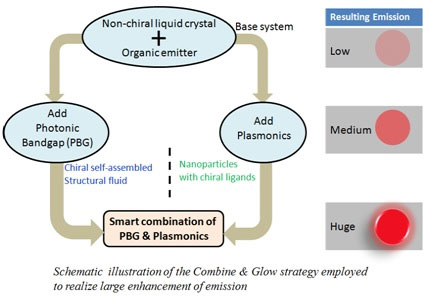 Scientists from Centre for Nano and Soft Matter Sciences (CeNS), an autonomous institute of the Department of Science & Technology, Govt. of India, have demonstrated high fluorescence and discrimination of chiral light in a chiral liquid crystal with the combination of two pathways of energy transfer developed by them. They can help intensify fluorescent dyes for various biosensing applications.
Scientists from Centre for Nano and Soft Matter Sciences (CeNS), an autonomous institute of the Department of Science & Technology, Govt. of India, have demonstrated high fluorescence and discrimination of chiral light in a chiral liquid crystal with the combination of two pathways of energy transfer developed by them. They can help intensify fluorescent dyes for various biosensing applications.Bio-sensors have become paramount importance in the field of drug delivery, bio-medicines, environmental monitoring, pathogen detections, etc. Among the various techniques, fluorescence-based probing offers several advantages owing to its simplicity, non-invasive, and multi-analyte optical detection character. However, the efficiency of the desired fluorophores could be annoyingly low due to their undesirable inherent chemical nature for autofluoration and self-degradation. Thus it is important to develop methodologies to externally enhance and modulate the fluorescence properties of such systems.
The team led by Dr. S Krishna Prasad at CeNS focussed their attention on the fluorescence arising from a deliberately chosen weak organic emitter to illustrate the power of judicially combining two independent pathways that they developed. The first of the two pathways is by incorporating the dyes into a photonic liquid, -- a chiral liquid crystal (CLC). A photonic system restricts the path of particular wavelengths of visible light to pass through it, which will result in selective reflection of a band of visible wavelength regions, referred to as photonic bandgap (PBG). Deploying a length-scale matching technique that they envisaged, the researchers in their study published in ChemPhotoChem, a Wiley journal, showed that the emission magnitude can be increased. An independent pathway was arrived at, by incorporating the plasmonic nanoparticles (PNPs) in the fluorescing, but non-chiral system.
The mechanism of plasmonic energy transfer from the PNPs to the emitter, termed as metal enhanced fluorescence (MEF), does increase the emission level. The highlight of the present work is the demonstration that with the proper design of the systems, it is possible to achieve best of both these situations to realize unprecedented photoluminescence levels that far exceed a mere summation of the contribution from the individual methods.
Ms Marlin Baral, a Senior Research Fellow at CeNS who made major contributions for this project, says, “This protocol also helps in effective discrimination of chiral light leading to the observation of large anisotropy or dissymmetry of the circular polarised luminescence from the inherent chirality of the parent chiral structural fluid. The magnitude of dissymmetry of the circularly polarised luminescence observed by us is comparable to the maximum reported till date, with the attraction that our systems are much simpler”.
Sachin Bhat, another Senior Research Fellow at CeNS, who prepared the nanoparticles with chiral promesogenic ligands, is thrilled at the opportunities such particles provide to effectively transfer chirality to the neighbouring matrix in addition to keeping the plasmonic characters intact. The researchers also found that the fluorescence could also be modulated by the application of low-magnitude electric fields. They emphasize that this methodology is generic and can thus be applied to most of the fluorescent dyes with a low level of photoluminescence emission for various biosensing applications.
Publication details:
1. M.Baral, S.K.Prasad, S.A.Bhatt, R.A.Nayak, C.V.Yelamaggad, ; (2020) ‘Conjunctive photoluminescence enhancement through plasmonic and photonic bandgap pathways in a chiral self-assembled system’ (in press, 10.1002/cptc.202000077)
2. M.Baral, V,N.Veerabhadraswamy, S.K.Prasad, C.V.Yellamagad, ‘Enhanced photoluminescence in a chiral nematic liquid crystal through polymer stabilization and an erasable 3-state memory device.’ Journal of Molecular Liquids, 2019 292, 111338
3. M.Baral, S.K.Prasad, H.Patel, A.S.Achalkumar, C.V.Yelamaggad, ‘Giant enhancement of photoluminescence and tertiary emission in a chiral nematic by matching photonic band gap and excitation wavelength.’ Journal of Molecular Liquids, 2018 262, 354.
1. M.Baral, S.K.Prasad, S.A.Bhatt, R.A.Nayak, C.V.Yelamaggad, ; (2020) ‘Conjunctive photoluminescence enhancement through plasmonic and photonic bandgap pathways in a chiral self-assembled system’ (in press, 10.1002/cptc.202000077)
2. M.Baral, V,N.Veerabhadraswamy, S.K.Prasad, C.V.Yellamagad, ‘Enhanced photoluminescence in a chiral nematic liquid crystal through polymer stabilization and an erasable 3-state memory device.’ Journal of Molecular Liquids, 2019 292, 111338
3. M.Baral, S.K.Prasad, H.Patel, A.S.Achalkumar, C.V.Yelamaggad, ‘Giant enhancement of photoluminescence and tertiary emission in a chiral nematic by matching photonic band gap and excitation wavelength.’ Journal of Molecular Liquids, 2018 262, 354.






























